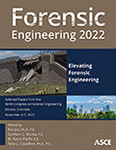Using Models in Forensic Engineering—All Models Are Wrong, but Some Are Useful
Publication: Forensic Engineering 2022
ABSTRACT
Computer models are useful for both structural design and forensic analysis. In the process of design, loads and materials must be assumed. In contrast, when investigating a failure, it is possible to know the materials and structural configuration as well as the loads applied at the time of failure. The necessary modelling is thus very different from the design process. Nonlinear models provide a powerful tool for forensic investigation, provided that they are used correctly. Many examples have been published in the American Society of Civil Engineers’ Journal of Performance of Constructed Facilities (ASCE JPCF) or presented at the eight ASCE Forensics Congresses, held approximately every three years since 1997. This overview paper will review case studies of modelling applied to forensic investigations, and also examine some of the issues associated with the use of such models.
Get full access to this article
View all available purchase options and get full access to this chapter.
REFERENCES
Abruzzo, J. (2015). “Disproportionate Collapse—How to Check the Computer Analysis,” proceedings of the ASCE 7th Forensic Congress, Miami, Florida, November 2015.
Box, G. E. P., W. Hunter, and S. Hunter. (2005). Statistics for Experimenters, second edition, 2005, page 440.
Bovo, M., and M. Savoia. (2018). “Numerical Simulation of Seismic-Induced Failure of a Precast Structure during the Emilia Earthquake,” J. Perform. Constr. Facil. Vol. 32 No. 1.
Brando, F., A. Iannitelli, L. Cao, E. A. Malsch, G. Panariello, J. Abruzzo, and M. J. Pinto. (2012). “Forensic Investigation Modeling (FIM) Approach: I35 West Bridge Collapse Case Study,” proceedings of the ASCE 6th Forensic Congress, San Francisco, November 2012.
Catella, N. D. (2015). “Case Studies of Finite Element Analysis in Structural Investigations,” proceedings of the ASCE 7th Forensic Congress, Miami, Florida, November 2015.
Delatte, N. J. (2007). Beyond Failure, ASCE Press, Reston, VA.
LZA (Lev Zetlin Associates). (1978). Report of the Engineering Investigation Concerning the Causes of the Collapse of the Hartford Coliseum Space Truss Roof on January 18, 1978,.
Lew, H. S. (1979). Investigation of Construction Failure of Reinforced Concrete Cooling Tower at Willow Island, West Virginia, NBSSIR 78-158, National Bureau of Standards, Washington, D.C., 1979.
Lew, H. S., N. J. Carino, S. G. Fattal, and M. E. Batts. (1981). “Investigation of Construction Failure of Harbour Cay Condominium in Cocoa Beach, Florida,”, National Bureau of Standards, Washington D.C. (NTIS PB-82 117 409).
Leyendecker, E. V., and S. G. Fattal. (1977). “Investigation of the Skyline Plaza Collapse in Fairfax Count, Virginia,”, National Bureau of Standards, Washington, D.C.
NTSB (National Transportation Safety Board). (2008). Collapse of I-35W Highway Bridge Minneapolis, Minnesota, August 1, 2007, Highway Accident Report, NTSB/HAR-08/03 https://www.ntsb.gov/investigations/AccidentReports/Reports/HAR0803.pdf.
Ortega, I. (2018). A Framework to Prevent Construction Failures Due to Computer-Related Errors, Proceedings of the 8th Forensic Engineering Congress, Austin, Texas, November 30, 2018.
Petroski, H. (1985). To Engineer Is Human. St. Martins Press, New York, NY.
Puri, S. P. S. (1998). “Avoiding Engineering Failures Caused by Computer-Related Errors,” Journal of Computing in Civil Engineering, Vol. 12, No. 4, October 1998, 170–172.
Schulman, L. L., and C. G. DesAutels. (2012). “Computational Fluid Dynamics Simulations to Predict Wind-Induced Damage to a Steel Building during Hurricane Katrina,” proceedings of the ASCE 6th Forensic Congress, San Francisco, November 2012.
Velivasakis, E. E. (1997). “The Willow Island Cooling Tower Scaffold Collapse: America’s Worst Construction Accident,” Forensic Engineering, ASCE, Virginia, pp. 94–105.
Wearne, P. (2000). Collapse: When Buildings Fall Down, TV Books, L.L.C. (www.tvbooks.com), New York, N.Y.
Yamin, L. E., J. F. Correal, J. C. Reyes, F. Ramirez, R. Rincón, A. I. Hurtado, and J. F. Dorado. (2018). “Sudden Collapse of the 27-Story Space Building in Medellin, Colombia,” J. Perform. Constr. Facil. Vol. 32 No. 3.
Information & Authors
Information
Published In
History
Published online: Nov 2, 2022
Authors
Metrics & Citations
Metrics
Citations
Download citation
If you have the appropriate software installed, you can download article citation data to the citation manager of your choice. Simply select your manager software from the list below and click Download.
